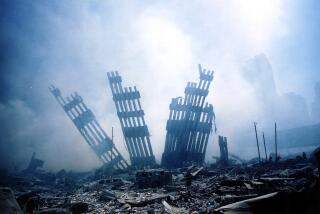Aramco Refines Role as Oil Titan : Energy: The Saudi-owned firm plans to spend billions expanding. The only roadblock may be the huge debt incurred in the Gulf War.
DHAHRAN, Saudi Arabia — Here at the fortress-like compound of Saudi Arabian Oil Co.--arguably the most influential and secretive business organization on Earth--daily life is fast regaining its equilibrium as the Persian Gulf crisis fades from memory.
The schools are filling up again, and “the lines in the grocery store are a clear indication that things are returning to normal,” said Micki Harman, whose husband is a pilot for Saudi Aramco, as the government-owned company is known.
After seven months of high anxiety, Saudi Aramco has emerged from the Gulf crisis with its respect enhanced and a future that promises to make the world’s largest oil concern more formidable than ever.
The company keeps the world supplied with steady streams of reasonably priced oil and the Saudi leadership with money to keep its restive population in check. It produced about 10% of the world’s oil last year.
Moving to further boost its riches and clout, Saudi Aramco plans to proceed with an expensive, long-term expansion to sharply increase its production capacity and expand its marketing and refining investments worldwide.
The company, though, may face major roadblocks in finding the money that it needs for its continued expansion, estimated at $15 billion to $35 billion, energy experts say. The Saudis, who own more than a quarter of the world’s crude-oil reserves, want to be able to produce 10 million barrels a day on a sustained basis by 1995.
The government could be forced to suspend or delay the expansion until it is able to take care of its huge obligations from the Gulf War, estimated at more than $60 billion, energy experts say. Saudi Aramco takes its orders from the Ministry of Petroleum and Mineral Resources.
Other potential problem areas are rising expansion costs, which could force the company to curtail its plans, and possible labor problems with its work force of Shiite Muslims, Aramco watchers say.
If the plans do materialize on time, they bode well for the stability of gasoline prices in the decade ahead following nearly 20 years of periodic instability, oil experts say.
A more productive Aramco would give the Saudi government even more clout within the Organization of Petroleum Exporting Countries, the oil cartel. “The more power and influence (the Saudis) have, the more stable the oil market will be,” said Fereidun Fesharaki, energy expert at the East-West Center, a research group in Honolulu.
Saudi Aramco is a tricky organization to gauge because it hides its important cards from public view. Even the company’s chief media relations official, Ismail Nawwab, would not speak publicly about its operations. However, several sources close to Aramco agreed to be interviewed if promised anonymity.
When it comes to publicity, the organization is kept on a short leash by the Ministry of Petroleum. “They do all the work, and we do the talking,” one ministry official said. Hisham Nazer, the petroleum minister, is also Aramco’s chairman.
Aramco produces nearly all the crude oil in a country the combined size of Texas and Alaska, where petroleum reserves exceed 250 billion barrels--enough to last more than 100 years at 1990 production levels.
Those reserves do not include recent strikes in the country’s heartland where Aramco has discovered valuable new sources of high-quality crude, the first finds in more than a decade for Saudi Arabia, which earned more than $27 billion from oil last year.
Most of the country’s petroleum is in the eastern province near Dhahran, a bland desert city that Aramco and its erstwhile owners literally started from scratch in the 1930s when oil was first discovered.
Once owned by four oil companies--Texaco, Mobil, Exxon and Standard Oil of California (now Chevron)--Saudi Aramco still has about 2,700 North Americans working in Saudi Arabia and plans to hire as many as 1,000 more for the crude-oil expansion program.
Two former U.S. oilmen are still on the Saudi Aramco board, which held a directors meeting in San Francisco last week. “Aramco depends on talent from the West because that’s where we get our technical expertise,” said Ali M. Dialdin, its general manager for training and career development.
The allure to work here is strong. Salaries plus benefits are roughly double that back home, housing is inexpensive, health care is free and crime is a virtual unknown.
Including dependents, more than 4,000 Americans and Canadians live in the main compound that is hidden from public view by two sets of security gates. Many spouses and children fled the country during the crisis, leaving gaping holes in school enrollment. But some students are returning, and more are expected this fall.
Within the compound is the feel of suburban America--with street names like Rolling Hills Boulevard and Elm Street. It is a place where compromise and discretion are the lubricants that prevent serious culture clash. Westerners drink home-brewed liquor in the privacy of their houses, and women may drive cars--both of which are taboo outside the gates.
Saudi Aramco was nationalized without the bitter feelings that characterized the takeover of other Middle East oil companies.
The process began in 1973 when the Saudi government bought a 25% interest in Arabian American Oil Co. for a reported $500 million from the previous owners. It concluded in 1988 when the firm was renamed Saudi Arabian Oil Co. and Saudi nationals were named chairman and chief executive.
Not everyone inside Saudi Arabia is happy with the 100% government ownership and control. One official close to the firm said Saudi Aramco would have been better off if it had kept even a small foreign ownership.
“This would have ensured freedom from government meddling and nepotism,” he said.
Saudi Aramco’s daily operations are supervised by a diffident geologist named Ali Naimi, 54, who succeeded American John J. Kelberer as chief executive.
Naimi’s background largely reflects Saudi Arabia’s metamorphosis from a primitive desert society to one of the world’s richest in five decades. Born into a tribe of Bedouins, Naimi spent his early years wandering the desert.
“We really had to eke out a living,” he said several years ago in the book “The Arabs,” by Times reporter David Lamb. “That’s something my children will never have to worry about.”
He took a clerk’s job at Aramco at 11, filling a slot vacated when his older brother, Abdullah, died of pneumonia. He worked his way up after attending schools from Beirut to California, including Stanford University, where he received a master’s degree.
Despite his job’s importance, Naimi is uneasy on the world stage. “I saw him recently at an OPEC meeting, and he looked like he would much rather be at home with his family,” said Joseph Story, an oil consultant in suburban Washington and a former Aramco employee.
Before the recent crisis, Saudi Aramco had planned a major expansion of its production capability, but the work was scheduled to take as long as 10 years. Saudi officials now feel the increase will be complete by 1995.
The timetable was accelerated sharply on Aug. 2, the infamous day when Iraq invaded Kuwait, moving its troops within easy striking distance of the Saudi oil fields. Surprising even itself, Saudi Aramco boosted its production to almost 8.5 million barrels a day by December--up from fewer than 5.5 million in July--to make up for the production losses from Kuwait and Iraq.
The boost helped stabilize world oil prices and gave outside experts a new respect for Saudi Aramco’s abilities. “They surprised everyone,” said Henry Schuler, petroleum expert at the Center for Strategic and International Studies in Washington. “They did a whale of a job.”
A further expansion to 10 million barrels won’t be as easy, energy experts say. For example, it will require the installation of expensive new equipment, such as collection plants that separate gas from crude oil, and will focus on producing a higher-quality crude.
“Going to 8.5 million barrels a day was not that difficult,” one Saudi Aramco consultant said. “Going to 10 million barrels is going to very difficult.”
(Actually, its sustained oil production in 1980 totaled nearly 10 million barrels a day, but much of that production equipment was mothballed when crude-oil prices plunged in the mid-1980s.)
Few experts expect Saudi Aramco to produce 10 million barrels a day when the current expansion is complete. Rather, they think that the Saudis want that potential as a way to keep OPEC in line and to enable them to step in immediately in case of major supply disruptions, energy analysts say.
“From where the Saudis sit, this is a political decision,” said the East-West Center’ Fesharaki. “It’s a move to increase their leverage inside OPEC.”
Saudi government officials have indicated that they are fed up with the cartel, in part because most of its membership showed so little support for the allied ouster of Iraq from Kuwait, OPEC watchers say.
They are also weary of their traditional role as OPEC’s swing producer. In that role, Saudi Aramco agreed to cut its production when the cartel wanted to stabilize crude-oil prices by reducing supply.
“They are sick and tired of being the swing producer,” said Mohammed Akacem, an OPEC watcher in Denver. “They have bills to pay.”
Saudi Aramco is rapidly changing its role in other ways as well. It has plans for expanding its overseas investments in gas stations and refineries throughout Europe, Asia and the United States.
Its goal is to diversify and reap additional profits in these “downstream” parts of the oil business. It has made plans to buy a half interest in a refinery in South Korea and is seeking entry in markets from France to Japan, energy experts say.
In its first move in that direction, Aramco bought a half interest in Texaco’s gas stations and refineries in the Eastern and Southern United States in late 1988 for $812 million. The partnership with Texaco, known as Star Enterprise, had pretax earnings of $377 million last year and $205 million in 1989.
Saudi Aramco’s recent petroleum strikes near Riyadh, the capital, has encouraged the search for oil outside the eastern province, site of all previous strikes. The finds near Riyadh are also important because of their quality, oil experts say.
The crude there is among the best in the world because of its lightness and low sulfur content. High-quality crudes, which are cheaper to refine into gasoline, fetch a premium of several dollars a barrel.
The Middle East Economic Survey, a weekly newsletter published in Nicosia, Cyprus, that is said to have excellent sources within the Saudi Ministry of Petroleum, wrote last year that the new finds may come from a single giant field that contains at least 30 billion barrels of oil.
That euphoria has since subsided, however. Three billion to 5 billion barrels are more likely, the Saudi oil ministry official said. “I’d love to see 30 billion,” he said, “but I don’t think it’s there.”
Aramco’s production expansion--which includes development of the high-quality Riyadh-area fields--faces serious obstacles, though.
Costs may skyrocket if Kuwait bids up the price of oil field service equipment and personnel. It will be rebuilding its damaged fields after the petroleum fires set by Iraqi troops are extinguished. Bids already received on one major oil-production project were double what the Saudis had expected, Schuler said.
Saudi Aramco also faces potential problems with a restive Shiite Muslim labor force that is reportedly unhappy within Aramco.
“The Shiites reach a certain level (within the company), and they don’t go any further,” said an executive of an American construction company that has close ties to Aramco. “That’s not the official policy, but that’s the way it is.”
The Saudi government has poured money into the eastern province to keep the large Shiite population happy--a flow that must continue if stability is to be maintained and internal revolts avoided, Schuler said. “You can paper over a lot of problems if you have the revenues to do it,” he said.
The biggest problem, though, may be that the Saudi government has its own uses for its oil income. For example, it pledged $13.5 billion last year to the United States for Desert Storm, most of which has yet to be paid.
As one Aramco official put it: “They are going to do everything to meet these commitments, but they are going to have a helluva problem paying for all these things.”
Yet, Aramco watchers expect the arguments for expansion to prevail. “The Saudis are well aware that they make their money from oil,” oil consultant Story said, “and they know they need to spend on oil as well.”
Saudi Arabian Oil Co. At a Glance What: World’s largest petroleum concern
Headquarters: Dhahran, in eastern Saudi Arabia near Persian Gulf
Ownership: Saudi government
Operations: Produces nearly all petroleum in Saudi Arabia, whose 257 billion barrels in proven reserves total more than 25% of world’s supply. Also owns 50% interest in Texaco’s marketing and refining operations in eastern and southern U.S.
Daily crude oil production: An estimated 6.2 million barrels in 1990. Now producing more than 7.5 million barrels daily
Financial results: Generated estimated $35 billion in oil revenue last year. Profit not disclosed
Aramco Milestones
1933: Saudi government gives Standard Oil of California (now Chevron) exclusive oil-drilling rights.
1934: Standard Oil forms new subsidiary, California Arabian Standard Oil Co., known as Casoc.
1937: Texas Co. (now Texaco) buys half interest in Casoc.
1938: Commercial quantities of oil discovered in Dhahran.
1939: Saudi Arabia exports first crude.
1944: Casoc changes name to Arabian American Oil Co.--Aramco for short.
1948: Standard Oil Co. of New Jersey (now Exxon) and Socony-Vacuum Oil Co. (now Mobil) buy into Aramco.
1949: Crude oil production reaches 500,000 barrels a day.
1958: Annual crude output exceeds 1 million barrels a day.
1973: Saudi government buys 25% interest in Aramco for reported $500 million.
1974: Government increases ownership to 60%.
1980: Government completes Aramco buyout for reported $1.5 billion. Average crude oil output hits all-time high of 9.63 million a day.
1988: Arabian American Oil Co. changes name to Saudi Arabian Oil Co.--or Saudi Aramco. Saudi Ali Naimi named Aramco CEO, replacing American John J. Kelberer.
1990: Aramco increases daily crude output in December to 8.5 million barrels to absorb lost supplies from Iraq and Kuwait.
More to Read
Sign up for Essential California
The most important California stories and recommendations in your inbox every morning.
You may occasionally receive promotional content from the Los Angeles Times.










